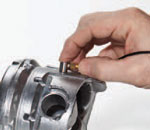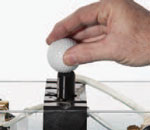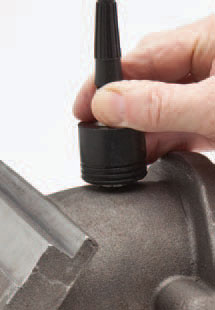Thickness Measurements on Plastics, Metals, etc.
Thickness Measurements on Plastics, Metals, Composites, Glass, Rubber, Ceramics
Using Single Element Transducers Single element transducers enable you to make accurate thickness measurements on metals, plastics, composites, glass, ceramics, and other materials. These transducers are available in a wide range of frequencies, diameters, and connector styles. In order to use a single element transducer with the 45MG, you must purchase either the Single Element software or the High Penetration software option.
|
| ||
Single Element Software Option The Single Element software option enables you to make very precise thickness measurements at a resolution of up to 0.0001 in. or 0.001 mm. Compatible with single element Microscan transducers ranging from 2.25 MHz to 30 MHz.
| Single Element High Penetration Software Option This option allows you to use low frequency single element transducers (as low as 0.5 MHz) to measure thick or highly attenuating materials such as rubber, fiberglass, castings, and composites. Included is the Single Element option.
| ||
| |||
Application Setup RecallApplication Setup Recall simplifies making thickness measurements. Select any of the stored transducers and the 45MG gauge recalls all relevant internal transducer parameters. Stored Standard Setups The 45MG includes 21 standard single element transducer setups for the most common applications. These default transducer setup can be used on wide variety of thickness applications. Stored Custom Setups The 45MG can store up to 35 custom single element transducer setups including calibration information. You can connect the appropriate transducer and recall the setup file and the instrument is ready to make thickness measurements on even the most difficult applications. | Material Sound Velocity MeasurementThe 45MG has the capability to make material sound velocity measurements. This standard feature is useful in applications where the speed of sound within the material can be correlated to other properties. Typical applications include cast metals to monitor the degree of nodularity, and composites/fiberglass to monitor variations in density. Reduction Rate Measurements Differential Mode and Reduction Rate Mode are standard features on the 45MG. Differential Mode shows the thickness variation from a pre-set thickness value. Reduction Rate calculates and displays the percent of thickness reduction after a material thinning process. A typical application is automotive sheet steel that is bent and formed to make car body panels. | ||
 Measure thin plastic material using a 20 MHz delay line transducer. | 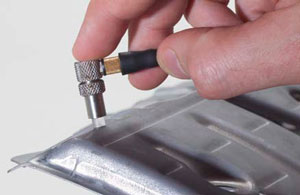 Measure metal thinning caused by bending or forming. | ||
 Measure thin glass with a V260-SM Sonopen® transducer. | 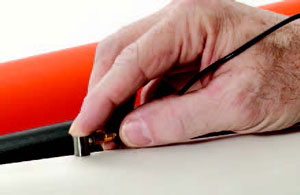 Measure the thickness of many materials including plastic, metal, rubber, glass, ceramic, and composites. | ||

